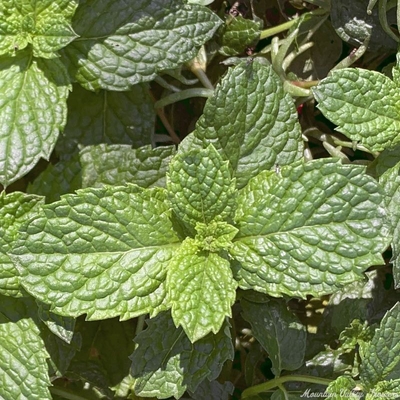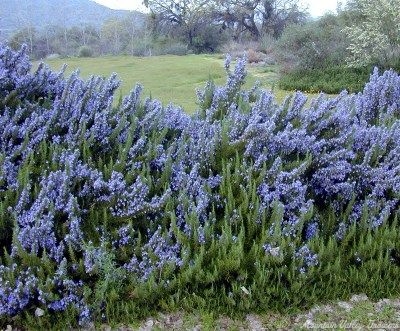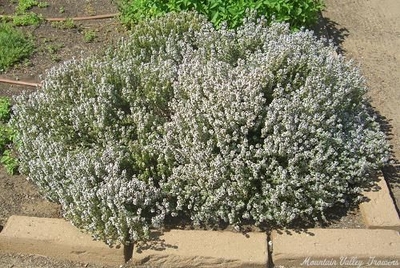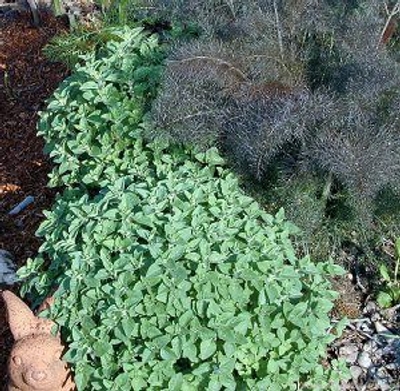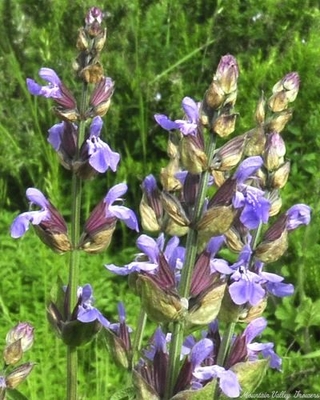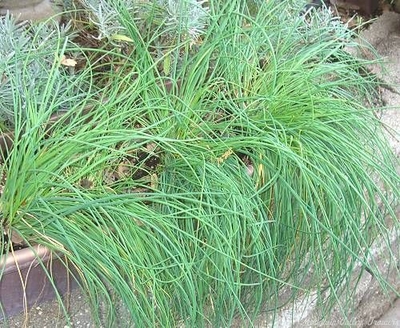Why we chose these plants
Cooking with herbs is like icing a cake: it makes the dish complete. It may seem daunting at first. There are so many herbs and so many recipes to choose from. And, while using recipes that include herbs is a good way to get started, the excitement comes when the unique flavor of each herb is understood and can be used to create your own special dish.
Here are three tips to get you explore the nuance of herbs.
Take a clean leaf of the herb and chew but don’t swallow. Experience your herbs like you would a fine wine; check the fragrant bouquet, let the leaf meet the tongue and chew thoughtfully. It is not necessary to swallow. Learning about the flavor of the herb this way will help you to decide if it will make the perfect pot roast or sorbet.
Add fresh chopped herbs (one at a time) to something bland yet familiar, like butter, sour cream or potatoes. This allows the intensity of the herb to stand on its own and helps you to know how much of the herb to add.
Just start playing; add a little Rosemary or Tarragon to the potatoes or the chicken; sprinkle some Oregano on your pizza or pasta; lay sprigs of Thyme on your roast. Keep notes, at least at first of what was pleasing, how much was used and what didn’t work. Note whether the herbs were fresh or dried or a combination of both. You will find this invaluable, especially when you start blending herbs together to get more complex flavors.
The most flavorful culinary herbs are harvested from well tended plants in their leaf making stage. All herbs have two phases of growth: the leaf stage and the flower (or reproductive stage). When the plant enters its flowering stage, leaf production slows or stops and the leaves on the plant may become bitter, grassy, woody, or yellowed. These leaves are not of optimum quality for cooking. Flowering can be delayed by harvesting kitchen herbs often. If your herbs grow too fast to use them all fresh, dry or process the extra for later use.
Flowers do make colorful, fragrant garnishes for salads, sautés, and desserts. And, you might want to consider growing two of the same culinary herb, one that can be allowed to flower and one that can be kept pruned for leaf production. Or, just enjoy both phases of growth on a single plant. After flowering, herbs should be cut back to encourage bushy new growth.
For detailed information on planting and maintaining your herb garden, please read our feature newsletter on culinary herb gardening. Home grown herbs will delight and surprise you with their clean, sharp flavors. This Kitchen Herb Garden Six Pack is our choice for the six most essential perennial cooking herbs.
Chives
Chives add a dash of flavor and elegance to so many different foods but it took the humble baked potato to make them a household word. Chives are best used fresh, but may be frozen. Fresh, they can be chopped fine and added to butters (great for corn on the cob), soft cheeses, and salads. Chives are often used as part of “Fines Herbes”. This blend of finely chopped fresh herbs is usually made up of equal parts of three or four of the following: Basil, Chervil, Chives, Marjoram, Mint, Parsley, Rosemary, Sage, Savory, Tarragon, or Thyme; and is usually added at the end of cooking so that the delicate flavors are not lost.
Bright purple Chive flowers make an eye catching and flavorful garnish sprinkled on salads, omelets, chicken and vegetable dishes. These attractive early spring flowers also make Chives a good choice for edging the herb garden.
When harvesting Chives, be sure to cut the spears completely to the ground; this will help eliminate grassy pieces in the clumps. Anytime it seems there are more yellow or brown spears than green ones, cut the whole plant back to the ground.
Easy to grow and fun to experiment with, Chives are hardy in zones 3-11, grow well in most soils, and make great container plants. For a tasty treat, make up a patio pot with a few plants of both Chives and Garlic Chives. Potted Chives should be divided and repotted every year or two. Planted in the ground, Chives multiply so rapidly that they usually have to be lifted and divided by the third year. Your friends will thank you for sharing your extras!
Kentucky Colonel Spearmint
Spearmints or green mints are most often used fresh to make sauces or drinks. There are many varieties of spearmints and one of our favorites is Kentucky Colonel Mint. It has large, sweet tasting leaves that make it the perfect choice for steeping in milk to make ice cream, pureeing with parmesan cheese and oil to make pesto, chopped fresh to make chicken salad and, of course, muddling to make mojitos.
Like all mints, Kentucky Colonel Mint, should be confined to a pot. Mints grow better in pots that have a wide surface area rather than a lot of depth. A 12 to 14 inch color bowl or window box makes a perfect mint pot, at least for the first year. After that, your mint will need to be divided and repotted with fresh soil each spring
Greek Oregano
Greek Oregano has a strong flavor, but it doesn’t hold up well to prolonged cooking, especially when used fresh. Harvest fresh leaves right before use. Wash and pat dry. If you are harvesting several hours ahead of time, wash, dry, wrap in dry paper towels, and refrigerate. They will keep a few hours this way. Or, whole stems can be placed in a glass or—even better—an attractive vase of water. This is a fun way to prepare for a meal. Pick several kinds of cooking herbs and make a culinary bouquet. Aromatic sprigs of Rosemary, Greek Oregano, Winter Savory, and Basil waiting close by the stove will make both the creative and digestive juices flow. Greek Oregano chopped and mixed with garlic, salt, and olive oil makes a great marinade for pork, beef, or roasted potatoes. Add a little Rosemary to the marinade and use it on poultry. Or use fresh leaves as a topping for homemade pizza (this is the way Greek Oregano was first used for pizza, not as ingredient in the sauce).
Dried Greek Oregano is a great way to get through the winter blues. It can be used for herbal marinades or can be added near the end of cooking to any tomato based sauce, sauté, stir fry, or egg dish. Try a sprinkle of dried Greek Oregano on your next grilled cheese sandwich. Fresh or dried Oregano can also be combined with other herbs to make a herb crusting mix for pork chops, tenderloins, or chicken breasts. When substituting dried herbs for fresh herbs, one tablespoon of fresh herbs equals about one teaspoon of dried herbs. Small amounts of Greek Oregano can be dried any time. Usually just laying the clippings left over from dinner’s harvest in a ceramic bowl will do the trick. But to harvest for winter use, it is easiest to dry all that will be needed at one time. Four to six weeks before the first frost, cut the herb back to about three inches above the ground Allow the plant to regrow and then, before frost, cut long stems (6 to 8 inches), tie in small groups, and hang out of sunlight in a warm room. Check often and, when crispy dry, store whole stems in glass jars in a dark cupboard or pantry. Leaving the leaves on the stems will preserve more flavor than stripping the leaves and grinding them into a powder. Greek Oregano can also be pureed with a bit of olive oil and frozen. Freeze flat in pint size zip lock bags. Because the olive oil doesn’t freeze, sections of this frozen pesto can be easily broken off and used.
Hardy IN ZONES 5-11, Greek Oregano, like most herbs, prefers six hours of sun each day to fully develop its mouth watering flavors. In hot summer areas, afternoon shade can cut down on watering and stress to the plant. And mulching is always a good practice to improve the soil and help keep root zone temperatures moderate. Any stress a plant goes through, such as parching and watering and parching and watering, will invite insects and disease. Greek Oregano may prove difficult to grow in areas of heat and humidity or excessive winter rain. Humidity can be dealt with somewhat by planting in raised beds or containers and by giving the plants plenty of space between them for air to circulate. Well drained soil will help during periods of excessive rain. Raised beds filled with organic topsoil and compost are good for this also. Anywhere puddles form after a rain is probably not a great place for Greek Oregano.
Rosemary
Wafting fragrance emitted from Rosemary on a hot sultry day can cool and refresh. The sound of the bees busily working the flowers is music to our freeway tired ears. Snapping a few branches and winding them into a loose wreath, we take the herb into the kitchen to contemplate the possibilities. No matter how much we enjoy Rosemary in the garden, Rosemary in the kitchen is what it is all about. Cooking with Rosemary is a true delight. As it flavors our food, it perfumes our home.
Any Rosemary can be used for cooking but we prefer our Upright Rosemary for both fresh and dried use. Cooking with Rosemary can be as simple as chopping up a few leaves to add to a leftover turkey sandwich or as elegant as mixing a bit of chopped fresh Rosemary with salt, pepper, and flour to rub on Cornish game hens before roasting. Because the leaves are thick, always chop them as finely as possible. Go cautiously at first because a little Rosemary goes a long way. Or, use whole stems by adding them near the end of cooking and then remove as you would a bay leaf. Try using 10 inch stems for barbecue skewers. There is no need to remove the leaves unless the Rosemary might overpower the food.
Rosemary is winter hardy in zones 8 through 11. It requires excellent drainage and full sun. In colder areas, It can be grown in a container throughout the summer and brought in for the winter. Give it a sunny spot or 16 hours of artificial lighting. Be careful not to over water. It is not necessary for the health of the plant to prune, but Rosemary can be pruned for shape after flowering has occurred, usually about mid spring. Pruning later will remove next year’s flowers.
Garden Sage
Culinary Sages are best used fresh, but they can be dried. For drying large amounts of leaves, cut back blooms in late spring and when the plant starts to grow new leaves. Wash the plants in the garden with a fine spray of water the night before; and the next morning, when the dew has dried, cut stems as long as possible without cutting into old wood. Hang these in bunches of three of four in a dark, dry, clean area. As soon as they are crispy dry seal them in an airtight container placed out of direct light. The flavor should remain potent for three or four months—at least until spring brings fresh, tender leaves again.
Besides the traditional use in stuffing, Sage is good with pork, sausage, other meats, and cheese. It is often combined with Thyme and used with beans and soups. Use Sage with fruits in vinegars; if the vinegar is a light colored elixir, try one of the variegated forms of Garden Sage like Tricolor Garden Sage or Golden Garden Sage. The bluish purple flowers of Garden Sage make an attractive garnish in salads, butters, soft cheeses, and ice cubes. Spice up hamburger night with a blend of freshly chopped or dried Sage, Mint, Rosemary, Oregano, and Basil.
Fresh picked ‘hands’ of Sage leaves can be used to make wreaths or tussie-mussies. They dry well and have that heavenly Sage fragrance.
Salvia officinalis is hardy in zones 5-11 and blooms profusely for about three or four weeks in spring. Planted in a row or in a block, it is one of the prettiest of all the Salvias. Garden Sage (Salvia officinalis), as well as all of its many forms, is short lived. Either becoming too woody for adequate production or dying out completely, these Sages usually need to be replaced every three or four years. It does help somewhat if the plants are pruned back beyond the flowers every year when the bloom is finished, but care should be taken not to prune into wood that has no growth showing.
English Thyme
English Thyme leaves may be small, but they pack a powerful punch. Thyme is one of the savory herbs, which are main course herbs used to flavor hearty meals, bone warming soups, and piquant sauces. They blend their essence with other savory herbs like Tarragon and Winter Savory to create memorable flavors. Thyme is one of the three traditional herbs used in “Fines Herbes”, and is often used in making Bouquet Garni”, a little herbal bouquet used when simmering foods. Try this one with Salmon: two sprigs each Tarragon, Parsley, and Dill, and one sprig of Thyme. Thyme has a warming flavor that is perfect with winter thyme treats like Baked Butternut Squash.
English Thyme blooms in spring and attracts early butterflies and many different kinds of beneficial flies and wasps. Its flowers are a favorite of honeybees. Plant in full sun for best flavor. Make sure the soil drains well and is fairly fertile. After Thyme blooms, it splays out messily in all directions. To prune, pull its many squirrelly stems up in a ponytail and crop them past the spent blooms (about a third of the way into the bush) to encourage lush new growth. Leaves can be used fresh any time. To dry a large quantity of Thyme, wait until the plant starts to regrow after pruning. In the early morning, after the dew has dried, cut three or four inch long stem segments and make small bundles tied with string or twist ties. Hang these out of direct light and check often for dryness. How long this will take depends on the moisture in the air. It is very important to make sure the Thyme is completely dry before storing because improperly dried herbs can mildew and rot. If the herb is crispy when crushed between the fingers then it is dry. When cooking with dried herbs, always measure out the desired quantity away from the steam of what you are cooking. This avoids introducing moisture into the jar which can cause the herbs to mold or clump together.
Culinary Herbs at a Glance
Chives: Use leaves and flowers fresh or frozen Good in soups, salads, salad dressings, eggs, dips, vegetables, chicken, soft cheese spreads, butters, white sauces, and fish. Chive Recipes
Kentucky Colonel Spearmint: Leaves fresh or dried Good in soups, salads, salad dressing, pestos, sauces, deserts, drinks and cocktails. Mint Recipes
Greek Oregano: Leaves fresh or dried Good in sauces (white and tomato), stews, soups, fish, lamb, pork, vegetables, butters, and vinegars. Culinary Oregano Recipes
Rosemary: Leaves fresh or dried, stems as BBQ skewers Good with beef, lamb, fish, poultry, stuffings, soups, stews, fruit cups, soups (chicken, pea, and spinach), vegetables, and marinades. Rosemary Recipes
Garden Sage: Leaves and flowers fresh or dried Good in stuffings (for fish, poultry, and meat), pâté, eggs, poultry, pork, beef, lamb, pasta, cheeses (cheddar, cream, and cottage), sauces (brown and meat), soups (cream and chowder), beef stews, and vegetables. Garden Sage Recipes
English Thyme: Leaves and flowers fresh or dried Good with game, beef, soft cheeses, fish, chowders, pâté, vegetables, and tomato sauce. Culinary Thyme Recipes
Additional plants to consider
The plants listed here make excellent additions to this collection. Click through to read more about them or add them to your order.

